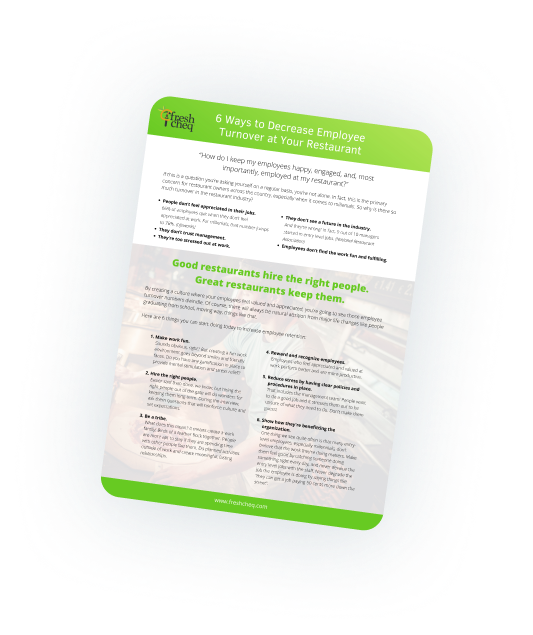Managing risk is one of the most critical functions of owning a restaurant. Restaurants that consistently utilize restaurant cooling logs minimize the risk of food poisoning. Focusing on practices that reduce risk factors known to contribute to foodborne illness is imperative for any restaurant brand. Let’s focus our attention to a lesser known food safety topic: the proper cooling of hot food.
Are Restaurants Using Restaurant Cooling Logs
Although most restaurant kitchen managers report that they have formal cooling processes (86%) and train staff on proper cooling (91%), a large number of managers indicate that they do not use tested and verified cooling processes (39%), they do not monitor time or temperature intervals during cooling processes (41%), and do not consistently calibrate kitchen thermometers (15%). Additionally, 86% of managers report that their cooling processes do not comply with FDA recommendations.
Most restaurants do not follow recommended cooling methods, such as:
- Take food temperatures at specific cooling intervals
- Refrigerate cooling food at shallow depths
- Ventilate cooling food
- Provide open-air space around the tops and sides of cooling food containers
- Avoid stacking cooling food containers on top of each other
Research shows that improper cooling practices are a major cause of restaurant food-borne illness. In the United States between 1998 and 2008, improper cooling practices contributed to 504 outbreaks linked to restaurants and delis. Research conducted in 2010 by the Centers for Disease Control and Prevention (CDC) and several state health departments including the Minnesota Department of Health, determined that many restaurants are not meeting the recommended cooling processes. Findings from these studies makes it clear that restaurants are putting themselves at risk and that greater emphasis needs to be placed on the use of cooling logs to reduce the risk of food-borne illness.
Why is Food Cooling Important?
Food has two important temperature danger zones where microorganisms flourish. When food cools to the 140-41 F range, pathogens that cause food-borne illness grow well. Within this range, temperatures between 125 and 70 F allow for the most rapid and risky growth of microorganisms. To minimize the presence of pathogens, food must pass through this range quickly. Keeping these risk factors in mind, most states recommend and enforce a two stage cooling process.
What is the Two Stage Restaurant Cooling Log Process?
Food codes state that cooked, potentially hazardous food that requires time and temperature food safety control be cooled as follows:
- From 140 to 70 F with 2 hours.
- From 70 to 41 F or below within 4 hours.
The initial two hour cool is the most important time period to monitor since the food is cooling through the most dangerous temperature range. When food fails to reach 70 F within the first two hours, it must be reheated to 165 F for 15 seconds and then cooled again or discarded.
Restaurant Food Cooling Best Practices
Cooling food in a controlled environment ensures that food is cooled safety and will not pose a risk to your guests. Controlling the cool down process using the FDA’s best practices will ensure that your restaurant is serving safe food. Understanding the factors that affect how quickly foods will cool down will help your staff control the cool down process.
Consider the following when cooling foods:
- Size and density of the food item. The thickness of the food will play the biggest part in how fast food cools. The denser the food item, the slower it will cool.
- Food storage container. Stainless steel transfers heat from foods faster than plastic. Shallow pans with a depth less than two inches allows heat to disperse more quickly. Initially loosely wrap food items.
Never place hot food in the cooler or freezer.
When hot food is placed in the cooler or freezer, it will not move through the temperature danger zone fast enough. Placing hot food in a cooler risks raising the temperature of other food items in the cooler entering them into the food danger zone, as well.
Reduce the size of food and divide.
Reduce the size and mass of cooling food items by cutting large food items into smaller pieces and dividing large containers into smaller containers.
Monitor the cooling process.
The only way to ensure that time and temperature requirements are being met is through monitoring. While paper cooling logs are commonly used, they are rarely completed correctly or completely. Digital cooling logs are recommended, like the ones offered by FreshCheq, which allow the cooling process to be more systematic and precise.
Approved food cooling methods.
Use the following approved methods to properly cool food without specified time frames.
- Ice-water bath and frequently stirring
- Ice paddles
- Adding ice if water is an ingredient
- Blast or tumble chiller.
- Food containers can be loosely covered or uncovered (if protected from overhead contamination)
Train staff on cooling methods.
FreshCheq trains staff for restaurant cooling logs accuracy, including:
- How and when to check temps.
- How to calibrate thermometers.
- How to keep accurate time-temp logs.



